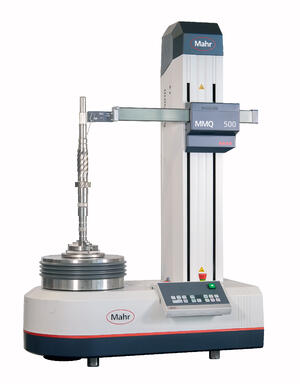MarForm MMQ 500 Form Tester
MarForm MMQ 500 Form Tester
The MarForm MMQ 500 is designed for speed. Its Z-axis vertical column allows movements with up to 100 mm/s—more than three times faster than conventional form measuring devices—for minimized cycle times. The newly developed automatic CNC centering and tilting table is a key factor in speeding up the total cycle time as it enables faster alignment than comparable models, thus increasing efficiency and productivity up to 75% faster than the market standard. This new centering and tilting table also features a high load-bearing capacity to enable the measurement of heavy workpieces, up to a mass of 80 kg (176 lbs.)n

Mahr Inc., a global manufacturer of precision measurement equipment used for dimensional metrology, today introduced its new MarForm MMQ 500, which extends Mahr's benchtop form tester portfolio with new levels of speed and flexibility. The MMQ 500 features optimized machine design and construction for the highest stability, precision, and speed. Powerful software enables both setup and measurement to be automated and extremely fast.
The MarForm MMQ 500 is designed for speed. Its Z-axis vertical column allows movements with up to 100 mm/s—more than three times faster than conventional form measuring devices—for minimized cycle times. The newly developed automatic CNC centering and tilting table is a key factor in speeding up the total cycle time as it enables faster alignment than comparable models, thus increasing efficiency and productivity up to 75% faster than the market standard. This new centering and tilting table also features a high load-bearing capacity to enable the measurement of heavy workpieces, up to a mass of 80 kg (176 lbs.)
Another important benefit of the MMQ 500 is the elimination of the need for an air supply by the use of a high-precision mechanical bearing for the rotary table. Mahr has been a leading producer of high-precision bearings for over 75 years, and the mechanical bearing used in the MMQ 500 is more accurate than most air bearings and up to 70 times stiffer, making the system less susceptible to external forces such as vibration.
The MMQ 500 is also versatile and made to be a master multitasker. The system can measure surface roughness according to applicable standards in the same setup as the form measurements. There is also the option to measure lead, or the fine thread-like microstructure, which may be present on shafts produced by typical turning and grinding methods.
"Getting high precision, reliable results, as quickly as possible is key to support the production processes of today's challenging manufacturing environments, and the MMQ 500 was designed with exactly this goal in mind," said Pat Nugent, Vice President Product Management of Mahr, Inc.
Additional benefits of the MarForm MMQ 500 include:
- Measures form, position, roughness, contour and lead in one setup
- Intuitive, easy-to-use software
- Highest axis accuracy
- Best repeatability, including for difficult measuring tasks
- Shortest floor-to-floor time on the market
- Universally applicable for everything from small workpieces of a few millimeters to heavy workpieces up to 80 kg (176 lbs.)





